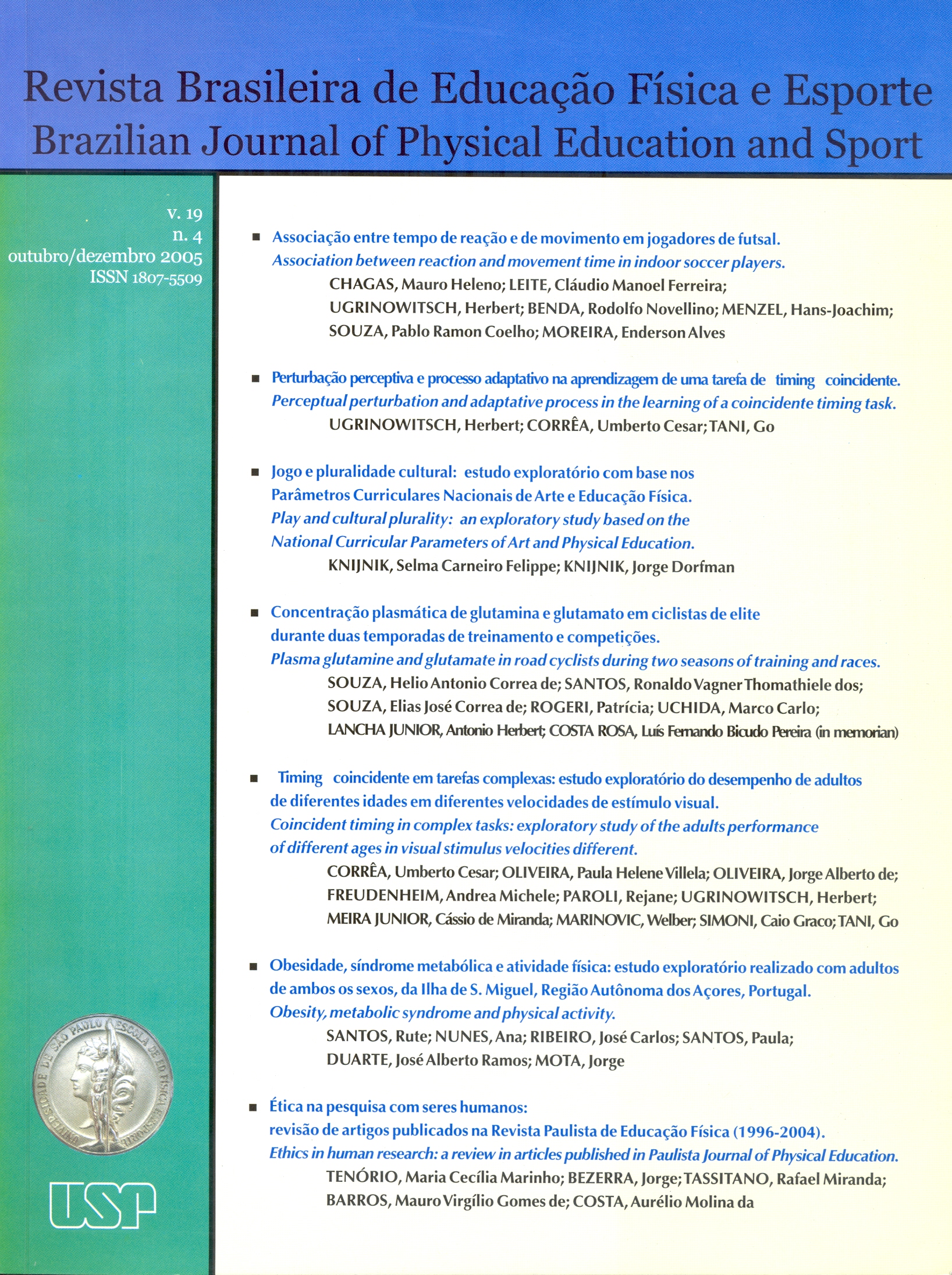Concentração plasmática de glutamina e glutamato em ciclistas de elite durante duas temporadas de treinamentos e competições
DOI:
https://doi.org/10.1590/S1807-55092005000400004Palabras clave:
Glutamina, Glutamato, Overreaching, Cortisol, CiclismoResumen
É bem descrito que atletas que praticam atividade física exaustivas podem apresentar, ao final de um macrociclo de competições, sinais de “overtraining”/”overreaching” que incluem a diminuição no desempenho e muitas mudanças fisiológicas, metabólicas e psicológicas. Na tentativa de identificar possíveis sinais do “overreaching”, nós estudamos um grupo de 10 ciclistas profissionais, peso 72,1 ± 3,5 kg, consumo máximo de oxigênio (VO2 máx) 73,96 ± 3,7 mL.kg-1.min-1, idade 23 ± 4,01 anos, durante dois macrociclos anuais consecutivos. O VO2 máx e a concentração sangüínea de lactato, durante um teste incremental máximo, foram utilizados para avaliar o desempenho dos atletas e a concentração plasmática de cortisol, glutamina e glutamato, como marcadores metabólicos do “overreaching”. Durante o período de dois anos, nove amostras de sangue foram coletadas por punção venosa após os períodos de treinamento de alta intensidade e de competições. O VO² máx (74,9 ± 1,69 mL.kg-1.min-1 e 77,62 ± 3,37 mL.kg-1.min-1, respectivamente início e final do primeiro macrociclo) e a concentração plasmática de lactato não tiveram alterações durante o estudo, contudo, ao final de ambos macrociclos, os atletas apresentaram sinais de fadiga, percebidos através da escala de esforço subjetivo de Borg e pelo fato de não conseguirem suportar as mesmas cargas ao final dos testes (exaustão precoce). A concentração plasmática de glutamina (559,8 µmo.l-1 para 531,7 µmo.l-1 no primeiro macrociclo e 438,7 µmo.l-1 para 393,06 µmo.l-1 no segundo macrociclo) e do glutamato (214 µmo.l-1 para 167,2 µmo.l-1 no primeiro macrociclo e 244,2 µmo.l-1 para 205,64 µmo.l-1 no segundo macrociclo) diminuíram e a concentração plasmática de cortisol (363,15 µmo.l-1 para 569,66 µmo.l-1 no segundo macrociclo) aumentou. Com isso, nós concluímos que durante um macrociclo competitivo as mudanças na concentração plasmática de glutamina, glutamato e cortisol, podem ser utilizadas como marcadores precoces de um estágio de “overreaching”.Descargas
Los datos de descarga aún no están disponibles.
Descargas
Publicado
2005-12-01
Número
Sección
naodefinida
Licencia
Todo o conteúdo da revista, exceto onde está identificado, está licenciado sob uma Licença Creative Commons (CC-BY)
Cómo citar
Souza, H. A. C. de, Santos, R. V. T. dos, Souza, E. J. C. de, Rogeri, P., Uchida, M. C., Rosa, L. F. B. P. C., & Lancha Junior, A. H. (2005). Concentração plasmática de glutamina e glutamato em ciclistas de elite durante duas temporadas de treinamentos e competições . Revista Brasileira De Educação Física E Esporte, 19(4), 295-306. https://doi.org/10.1590/S1807-55092005000400004


